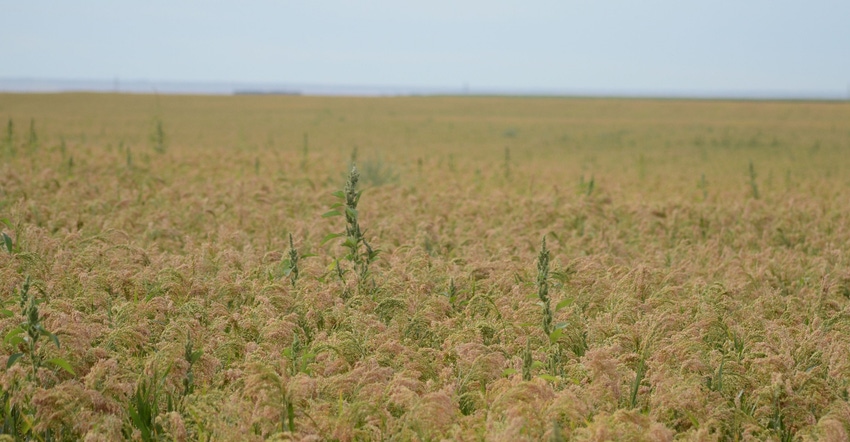
After over 10 years of development, growers in the Nebraska Panhandle and other regions of the High Plains will have access to a new proso millet variety from the University of Nebraska-Lincoln. The variety, Plateau, which will be available this spring, is the first waxy proso millet variety to be launched in the U.S.
"There are two types of varieties of proso millet. One is waxy millet, and the other is non-waxy millet. Waxy is sticky in nature due to being high in amylopectin [over 90%] and no or very little amylose starch, and non-waxy is non-sticky [low amylopectin of less than75%]," says Dipak Santra, Extension alternative crops breeding specialist at the Panhandle Research and Extension Center.
"Plateau is a waxy millet, and it can be used for conventional purposes like bird seed, as well as for specialty human food,” Santra says. “It has a specific use in food markets in countries like Japan, South Korea and China."
Currently, the majority of proso millet that's raised in the U.S. for export is used for bird feed in Europe. With this waxy, amylose-free proso millet, there is more potential for use in these food markets.
Plateau’s origin
The development of Plateau started with Santra's predecessor, David Baltensperger, in the early 2000s. At the time, a Japanese food company with a branch in Denver expressed interest in food products from waxy proso millet, which wasn't available in Nebraska. So, Baltensperger searched through the USDA germplasm bank in Ames, Iowa, and found a Chinese parent line of waxy proso millet. However, after he planted that waxy variety, it was still flowering when local varieties were ready to harvest. So, Baltensperger crossed it with Huntsman — a popular proso millet variety in Nebraska — to create a variety more suited to Panhandle growing conditions.
Baltensperger left Nebraska for a new position at Texas A&M University in the mid-2000s, but Santra picked up where he left off, growing and testing the cross between waxy and non-waxy millet. Now, after more than 15 years growing and testing for various characteristics, Plateau will be commercially available to farmers this spring.
Leon Kriesel of Kriesel Certified Seed in Gurley, Neb., the exclusive seed producer of the new variety, has been working with Japanese buyers to help create a specialty market for it over the last year. However, countries from South Korea to China to Germany to Slovenia have also expressed interest in waxy proso millet.
"It's different marketing. In Japan, they use it as an additive to food, a sprinkle on cereal or salad. We're probably replacing part of a market, because up until this point, Japan sourced all of their waxy-type millets out of China," Kriesel says.
However, with a decline in volume from China, Japanese buyers are looking to other sources, providing an opportunity for Nebraska growers to market to them — although marketing to a country with different tastes means different requirements for suppliers.
"It's about quality. What can you present them?" Kriesel says. "When you go to foreign markets, some are very similar to the U.S. market, and some are like Japan — they view food very differently. They're very concerned about what's in the food, if there is any contamination or allergens. Food is more revered in their country, so the manufacturers want people to trust them."
That's why Plateau will be sold as certified seed only (CSO) to ensure no seed is saved and to protect purity. Meanwhile, Plateau can be grown as an identity-preserved (IP) crop by farmers and delivered to certain locations for a premium — or can be grown for conventional bird seed markets.
Yields have been comparable to those of Huntsman — about 40 to 50 bushels per acre. Kriesel notes agronomically, Plateau is similar to other millets. It's somewhat finer-stemmed, with a finer plant head. It's a medium-maturity variety with a medium plant height and responds well to fertilizer. "This year, one field of Plateau was our highest yielder," Kriesel says. "I didn't have a perfect comparison this past year, but we had some fields of Plateau that broke the 70-bushel barrier in really good fields."
Santra, the only proso millet breeder in the U.S., and one of a handful worldwide, notes as a low-gluten crop that requires less water to grow, proso millet not only provides marketing opportunities for growers, but also an opportunity to reduce their water footprint.
While Santra continues research to develop new proso millet varieties, including waxy and non-waxy types, he hopes the release of Plateau for use in specialty markets will open up doors for growers to improve their bottom line. "That millet for specific food use will hopefully be more profitable than non-waxy millet, which is used for traditional bird seed," he says. "Hopefully, it will provide some increase in margin for the farmers."
About the Author(s)
You May Also Like




